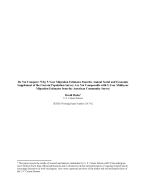Who Has a Second-Generation Educational Attainment Advantage?
Who Has a Second-Generation Educational Attainment Advantage?
Abstract
Educational attainment for the population aged 25 and older has been shown to be higher for the second generation (who have at least one foreign-born parent) when compared to the first-generation foreign born, and in some cases, when compared to the third-and-higher generation (who have native-born parents). However, the size of an educational advantage for the second generation may depend on sex, race, and Hispanic origin. Using pooled data from the 2007 to 2016 Current Population Surveys, this paper examines educational attainment by generational status, race and Hispanic origin, year, sex, and related sociodemographic characteristics. Results show that the second-generation was more likely to attain high school and bachelor’s degrees. Overall, a smaller second-generation advantage over the third generation was found for females, Hispanics, and Asians. A larger second-generation advantage over the third generation was found for males, Blacks and Whites. In addition, first-generation Blacks, Asians, and Whites had higher likelihoods of bachelor’s degree attainment compared to the third-and-higher generation. For almost all race, gender and generational groups, educational attainment increased to some degree between 2007 and 2016.





